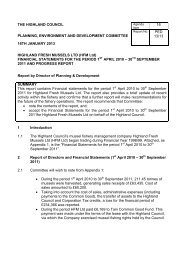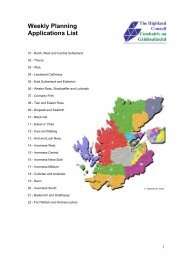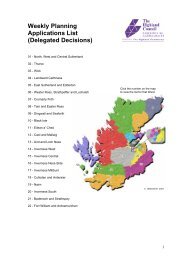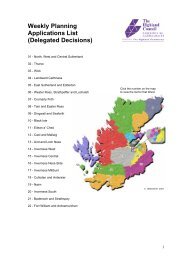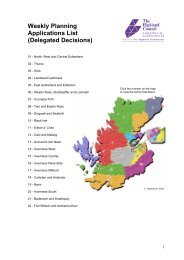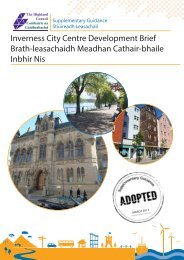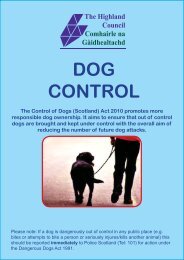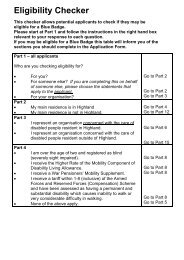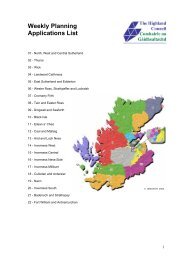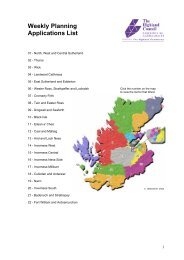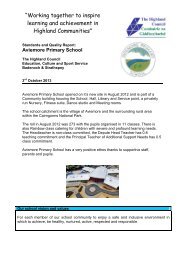Notice of Review 11-00044 Dingwall Highland
Notice of Review 11-00044 Dingwall Highland
Notice of Review 11-00044 Dingwall Highland
Create successful ePaper yourself
Turn your PDF publications into a flip-book with our unique Google optimized e-Paper software.
This pair have been well studied and the male is known to regularly fish<br />
the Inner Cromarty Firth near to the Conon Islands. The outbound flight<br />
line is from Loch Ussie directly over the Conon roundabout and<br />
approximately 1km to the south <strong>of</strong> the proposed turbine location. The<br />
inbound flight is along the same route, and Ospreys carrying fish to the<br />
nest take the easiest route, avoiding high ground.<br />
Additional pairs nest upriver <strong>of</strong> the Conon Islands but at distances greater<br />
than the Loch Ussie pair. All flight lines associated with these pairs are<br />
away from the proposed turbine location. No pairs nest immediately to the<br />
north <strong>of</strong> <strong>Dingwall</strong>.<br />
Therefore, there are no issues associated with the proposed development<br />
and disturbance to nests or collision risk to known breeding pairs. And the<br />
proposed development is not sited near a fishing loch which could<br />
potentially attract non-breeding birds.<br />
Potential adverse impacts on Osprey are therefore predicted as negligiblelow.<br />
Red Kite Milvus milvus<br />
Annex 1 and Schedule 1.<br />
UK breeding population estimated at c.1000 pairs.<br />
Red Kites were reintroduced to north Scotland in 1989-1993 and following<br />
the successful release <strong>of</strong> birds, a breeding population has established.<br />
However, this breeding population (55 pairs in 2009) is still largely<br />
centred on the Black Isle and parts <strong>of</strong> Easter Ross. Pairs have been slow to<br />
spread out, although they are now breeding eastwards as far as Tain. A<br />
relatively high density <strong>of</strong> breeding pairs occurs in the <strong>Dingwall</strong> area.<br />
The moorland edge, mixed woodlands, coniferous plantation and<br />
permanent grazing which encompass an area from Strathpeffer in the west<br />
to Evanton in the east (including the <strong>Dingwall</strong> area) comprise an important<br />
foraging area for a number <strong>of</strong> established pairs, and much <strong>of</strong> the higher<br />
ground in particular is important as a nursery area for both juvenile and<br />
immature Red Kites.<br />
There are currently no pairs <strong>of</strong> Red Kites breeding within 2km <strong>of</strong> the<br />
proposed turbine location. A pair did breed on the Conon Islands in 2008,<br />
but the site has been unoccupied in subsequent breeding seasons<br />
(approximately 1.8km from the turbine location). The nearest occupied<br />
nest site is approximately 3.75km from the potential site area. Soaring<br />
Red Kites are nonetheless a common feature <strong>of</strong> the area in general and<br />
birds are commonly seen in the <strong>Dingwall</strong> area, including over the town<br />
itself. Indeed, two adults and a juvenile Red Kite were observed in the<br />
9



